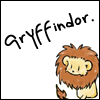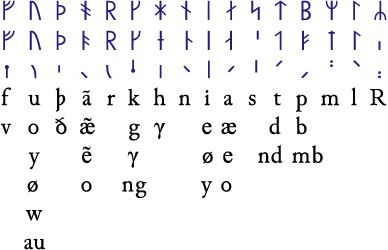|
|
|
|
|
|
|
|
|
 Posted: Tue Feb 16, 2016 10:20 am Posted: Tue Feb 16, 2016 10:20 am
|
|
|
|
|
|
|
|
|
|
 Posted: Tue Feb 16, 2016 10:23 am Posted: Tue Feb 16, 2016 10:23 am

 ════════════════════════ ════════════════════════
Hɪsᴛᴏʀʏ ᴏғ Mᴀɢɪᴄ || Rᴀᴠᴇɴᴄʟᴀᴡ Pʀᴏғᴇssᴏʀ || Sᴛᴜᴅʏ ᴏғ Aɴᴄɪᴇɴᴛ Rᴜɴᴇs
════════════════════════
Powell walked into the classroom, a spring in his step as he busied himself around the classroom, getting it ready for the day. After he was satisfied, he then turned toward the board in the room and quickly wrote out the lesson as well as several lines. Finished, he turned toward the class and waited for the students to enter.
Professor Powell Introduction to Younger Futhark Runes
"Welcome to your third year in Ancient Runes. Over the last two years, we have reviewed the more common forms of Runes. This year, we shall explore the Younger Futhark, so named because of the fact they were used during the eighth century and onward. At the end of the eighth century an unknown rune-master reformed the Elder Futhark having reduced it to sixteen runes. By the tenth century the new form of writing was accepted in the whole of Scandinavia. It is this set of runes that may be properly called Viking runes, since they were used by the Scandinavians during the Viking Age."
Grayson then pointed to the three lines of runes he had writen. "As you can see, there are three variations on these runes. They are called the Long Branch, the Short Twig, and the Staveless. Each of these developed during this time frame, and each has a distinctive way in writing them. Not all Scandinavian countries used the same rune sets, as you can see, and each were used for different reasons. For example, the Short Twig and Long Branch sets of runes were common in several countries for daily use, while the Staveless variety might have been used in code writing. Now, I want you to practice writing your names in these systems, since the more you practice, the more you will be able to recognize them and be able to apply them to what you are reading."
════════════════════════Location: History of Magic Classroom
Thinking: Class time!
Taken by: Amata Harlowe
OOC: OOC: Okay, might be a bit of a homework assignment, but an easy one. Just use this link to go to the site I use, and type out your name, select either Long Branch, Short Twig, or Staveless, and then select Convert. When that's done, just print screen your result, crop the image down, and then post it in class. That's it, and the translator is really fun to use! ^^
If you are quoted in this course, please post. There has been a seriously lack of posts from students who have been supposed to be in this class, and I will deduct ten points from people that don't post at least once in this year.
Now where did I put that wand?
|
 |
 |
|
|
|
|
|
|
|
|
|
|
|
|
|
|
|
 Posted: Tue Feb 16, 2016 1:31 pm Posted: Tue Feb 16, 2016 1:31 pm
|
|
|
|
|
|
|
|
|
|
 Posted: Thu Feb 18, 2016 12:54 pm Posted: Thu Feb 18, 2016 12:54 pm
Made something better, he kept it for himself.
I'm not that stupid, I just need a lot of help-
To understand how stupid you really are.
Down at the bottom of the ocean, I lay down;
Nobody's coming; just continue to drown.
And no one here could ever stop my ruin now.
And I know I've got a lot to fear; you'll get me out...
Oh, God, just get me out of here.  α и т ı g ø и e
¢ α š š ı ø ρ e ı α
ł ı ł ł α и т ı и e яανeи¢łαω │ fıfтн чeαя │ ρυяeвłøøđ │ še¢øиđ вøяи Anti spent most of the time quietly working on the assignment, while Selina asked some question about staveless runes. It was early, and she wasn't much of a morning person. Besides, she'd just come from Defense, and she had Alchemy this afternoon, both fairly intensive classes.
 Nobody's daughter, she never was, she never will-
Be beholden to anyone she cannot kill!
You don't understand how damaged we really are.
You don't understand how evil we really are.
And I will dig my own grave, yeah...
I'm misbegotten; I am the last one you save here.
Of course I'll sleep forever and forever;
Anesthetize all your horrors away.
|
 |
 |
|
|
|

The Forgotten Weasley Crew
|
|
|
|
|
|
|
|
|
|
|
|
 Posted: Thu Feb 18, 2016 7:27 pm Posted: Thu Feb 18, 2016 7:27 pm
 Location: Location: Study of Ancient Runes - Tuesday @ 9:00am Grace came to class straight from defense. Taking a seat she was more away after her earlier class. As they jumped right into class, she took some notes on the different rune variants. When asked to work on the three types, Grace got her head into her books and began working on it. She spent most of the class time working on it. She only glanced up for a moment when Selina asked Professor Powell a question about the shaveless runes. Something told her that chances were the shaveless was used for code. It sure looked like it.   Status: Happy With: Class... Anti, Selina, Professor Powell Wearing: Ravenclaw Uniform OOC: --- Status: Happy With: Class... Anti, Selina, Professor Powell Wearing: Ravenclaw Uniform OOC: --- Lily the Rabbit Well you certainly know what you want.
And I won't argue with such a mind as yours.
Ravenclaw!
|
 |
 |
|
|
|
|
|
|
|
|
|
|
|
|
 Posted: Mon May 23, 2016 10:48 am Posted: Mon May 23, 2016 10:48 am
|
|
|
|
|
|
|
|
|
|
|
|
|
 Posted: Mon May 23, 2016 10:51 am Posted: Mon May 23, 2016 10:51 am

 ════════════════════════ ════════════════════════
Hɪsᴛᴏʀʏ ᴏғ Mᴀɢɪᴄ || Rᴀᴠᴇɴᴄʟᴀᴡ Pʀᴏғᴇssᴏʀ || Sᴛᴜᴅʏ ᴏғ Aɴᴄɪᴇɴᴛ Rᴜɴᴇs
════════════════════════
Powell walked into the classroom, a spring in his step as he busied himself around the classroom, getting it ready for the day. After he was satisfied, he then turned toward the board in the room and quickly wrote out the lesson as well as several lines. Finished, he turned toward the class and waited for the students to enter.
Professor Powell Introduction to Younger Futhark Runes
"Welcome to your third year in Ancient Runes. Over the last two years, we have reviewed the more common forms of Runes. This year, we shall explore the Younger Futhark, so named because of the fact they were used during the eighth century and onward. At the end of the eighth century an unknown rune-master reformed the Elder Futhark having reduced it to sixteen runes. By the tenth century the new form of writing was accepted in the whole of Scandinavia. It is this set of runes that may be properly called Viking runes, since they were used by the Scandinavians during the Viking Age."
Grayson then pointed to the three lines of runes he had writen. "As you can see, there are three variations on these runes. They are called the Long Branch, the Short Twig, and the Staveless. Each of these developed during this time frame, and each has a distinctive way in writing them. Not all Scandinavian countries used the same rune sets, as you can see, and each were used for different reasons. For example, the Short Twig and Long Branch sets of runes were common in several countries for daily use, while the Staveless variety might have been used in code writing. Now, I want you to practice writing your names in these systems, since the more you practice, the more you will be able to recognize them and be able to apply them to what you are reading."
════════════════════════Location: History of Magic Classroom
Thinking: Class time!
Taken by: Amata Harlowe
OOC: OOC: Okay, might be a bit of a homework assignment, but an easy one. Just use this link to go to the site I use, and type out your name, select either Long Branch, Short Twig, or Staveless, and then select Convert. When that's done, just print screen your result, crop the image down, and then post it in class. That's it, and the translator is really fun to use! ^^
If you are quoted in this course, please post. There has been a seriously lack of posts from students who have been supposed to be in this class, and I will deduct ten points from people that don't post at least once in this year.
Now where did I put that wand?
|
 |
 |
|
|
|
|
|
|
|
|
|
|
|
|
 Posted: Mon Aug 15, 2016 12:23 pm Posted: Mon Aug 15, 2016 12:23 pm
|
|
|
|
|
|
|
|
|
|
|
|
|
 Posted: Mon Aug 15, 2016 12:26 pm Posted: Mon Aug 15, 2016 12:26 pm

 ════════════════════════ ════════════════════════
Hɪsᴛᴏʀʏ ᴏғ Mᴀɢɪᴄ || Rᴀᴠᴇɴᴄʟᴀᴡ Pʀᴏғᴇssᴏʀ || Sᴛᴜᴅʏ ᴏғ Aɴᴄɪᴇɴᴛ Rᴜɴᴇs
════════════════════════
Powell walked into the classroom, a spring in his step as he busied himself around the classroom, getting it ready for the day. After he was satisfied, he then turned toward the board in the room and quickly wrote out the lesson as well as several lines. Finished, he turned toward the class and waited for the students to enter.
Professor Powell Introduction to Younger Futhark Runes
"Welcome to your third year in Ancient Runes. Over the last two years, we have reviewed the more common forms of Runes. This year, we shall explore the Younger Futhark, so named because of the fact they were used during the eighth century and onward. At the end of the eighth century an unknown rune-master reformed the Elder Futhark having reduced it to sixteen runes. By the tenth century the new form of writing was accepted in the whole of Scandinavia. It is this set of runes that may be properly called Viking runes, since they were used by the Scandinavians during the Viking Age."
Grayson then pointed to the three lines of runes he had writen. "As you can see, there are three variations on these runes. They are called the Long Branch, the Short Twig, and the Staveless. Each of these developed during this time frame, and each has a distinctive way in writing them. Not all Scandinavian countries used the same rune sets, as you can see, and each were used for different reasons. For example, the Short Twig and Long Branch sets of runes were common in several countries for daily use, while the Staveless variety might have been used in code writing. Now, I want you to practice writing your names in these systems, since the more you practice, the more you will be able to recognize them and be able to apply them to what you are reading."
════════════════════════Location: History of Magic Classroom
Thinking: Class time!
Taken by: Amata Harlowe
OOC: OOC: Okay, might be a bit of a homework assignment, but an easy one. Just use this link to go to the site I use, and type out your name, select either Long Branch, Short Twig, or Staveless, and then select Convert. When that's done, just print screen your result, crop the image down, and then post it in class. That's it, and the translator is really fun to use! ^^
If you are quoted in this course, please post. There has been a seriously lack of posts from students who have been supposed to be in this class, and I will deduct ten points from people that don't post at least once in this year.
Now where did I put that wand?
|
 |
 |
|
|
|
|
|
|
|
|
|
|
|
|
 Posted: Wed Aug 17, 2016 3:25 pm Posted: Wed Aug 17, 2016 3:25 pm
|
|
|
|
|
|
|
|
|
|
|
|
|
 Posted: Tue Nov 15, 2016 12:40 pm Posted: Tue Nov 15, 2016 12:40 pm
|
|
|
|
|
|
|
|
|
|
 Posted: Tue Nov 15, 2016 12:43 pm Posted: Tue Nov 15, 2016 12:43 pm

 ════════════════════════ ════════════════════════
Hɪsᴛᴏʀʏ ᴏғ Mᴀɢɪᴄ || Rᴀᴠᴇɴᴄʟᴀᴡ Pʀᴏғᴇssᴏʀ || Sᴛᴜᴅʏ ᴏғ Aɴᴄɪᴇɴᴛ Rᴜɴᴇs
════════════════════════
Powell walked into the classroom, a spring in his step as he busied himself around the classroom, getting it ready for the day. After he was satisfied, he then turned toward the board in the room and quickly wrote out the lesson as well as several lines. Finished, he turned toward the class and waited for the students to enter.
Professor Powell Introduction to Younger Futhark Runes
"Welcome to your third year in Ancient Runes. Over the last two years, we have reviewed the more common forms of Runes. This year, we shall explore the Younger Futhark, so named because of the fact they were used during the eighth century and onward. At the end of the eighth century an unknown rune-master reformed the Elder Futhark having reduced it to sixteen runes. By the tenth century the new form of writing was accepted in the whole of Scandinavia. It is this set of runes that may be properly called Viking runes, since they were used by the Scandinavians during the Viking Age."
Grayson then pointed to the three lines of runes he had writen. "As you can see, there are three variations on these runes. They are called the Long Branch, the Short Twig, and the Staveless. Each of these developed during this time frame, and each has a distinctive way in writing them. Not all Scandinavian countries used the same rune sets, as you can see, and each were used for different reasons. For example, the Short Twig and Long Branch sets of runes were common in several countries for daily use, while the Staveless variety might have been used in code writing. Now, I want you to practice writing your names in these systems, since the more you practice, the more you will be able to recognize them and be able to apply them to what you are reading."
════════════════════════Location: History of Magic Classroom
Thinking: Class time!
Taken by: Amata Harlowe
OOC: OOC: Okay, might be a bit of a homework assignment, but an easy one. Just use this link to go to the site I use, and type out your name, select either Long Branch, Short Twig, or Staveless, and then select Convert. When that's done, just print screen your result, crop the image down, and then post it in class. That's it, and the translator is really fun to use! ^^
If you are quoted in this course, please post. There has been a seriously lack of posts from students who have been supposed to be in this class, and I will deduct ten points from people that don't post at least once in this year.
Now where did I put that wand?
|
 |
 |
|
|
|
|
|
|
|
|
|
|
|
|
|
|
|
 Posted: Mon Feb 13, 2017 1:03 pm Posted: Mon Feb 13, 2017 1:03 pm
|
|
|
|
|
|
|
|
|
|
 Posted: Mon Feb 13, 2017 1:05 pm Posted: Mon Feb 13, 2017 1:05 pm

 ════════════════════════ ════════════════════════
Hɪsᴛᴏʀʏ ᴏғ Mᴀɢɪᴄ || Rᴀᴠᴇɴᴄʟᴀᴡ Pʀᴏғᴇssᴏʀ || Sᴛᴜᴅʏ ᴏғ Aɴᴄɪᴇɴᴛ Rᴜɴᴇs
════════════════════════
Powell walked into the classroom, a spring in his step as he busied himself around the classroom, getting it ready for the day. After he was satisfied, he then turned toward the board in the room and quickly wrote out the lesson as well as several lines. Finished, he turned toward the class and waited for the students to enter.
Professor Powell Introduction to Younger Futhark Runes
"Welcome to your third year in Ancient Runes. Over the last two years, we have reviewed the more common forms of Runes. This year, we shall explore the Younger Futhark, so named because of the fact they were used during the eighth century and onward. At the end of the eighth century an unknown rune-master reformed the Elder Futhark having reduced it to sixteen runes. By the tenth century the new form of writing was accepted in the whole of Scandinavia. It is this set of runes that may be properly called Viking runes, since they were used by the Scandinavians during the Viking Age."
Grayson then pointed to the three lines of runes he had writen. "As you can see, there are three variations on these runes. They are called the Long Branch, the Short Twig, and the Staveless. Each of these developed during this time frame, and each has a distinctive way in writing them. Not all Scandinavian countries used the same rune sets, as you can see, and each were used for different reasons. For example, the Short Twig and Long Branch sets of runes were common in several countries for daily use, while the Staveless variety might have been used in code writing. Now, I want you to practice writing your names in these systems, since the more you practice, the more you will be able to recognize them and be able to apply them to what you are reading."
════════════════════════Location: History of Magic Classroom
Thinking: Class time!
Taken by: Amata Harlowe
OOC: OOC: Okay, might be a bit of a homework assignment, but an easy one. Just use this link to go to the site I use, and type out your name, select either Long Branch, Short Twig, or Staveless, and then select Convert. When that's done, just print screen your result, crop the image down, and then post it in class. That's it, and the translator is really fun to use! ^^
If you are quoted in this course, please post. There has been a seriously lack of posts from students who have been supposed to be in this class, and I will deduct ten points from people that don't post at least once in this year.
Now where did I put that wand?
|
 |
 |
|
|
|
|
|
|
|
|
|
|
|
|
|
|
|
 Posted: Mon Feb 13, 2017 5:59 pm Posted: Mon Feb 13, 2017 5:59 pm
 Fianna Grey Gryffindor │ Fifth Year │ Fifteen Years Old │ Single
After taking her Dark Arts class, Fianna welcomed the chance to unwind in Ancient Runes Study. Yeah, she figured that made her seem a bit weird, but then she saw Runes as not just another way of writing, but another form of art, something she'd always been interested in. She started working on the exercise Professor Powell assigned as soon as the lecture had ended, and she took care to make a good job of it.

.      Turn your magic on, to me she'd say
"Everything you wants a dream away
We are legends, every day"
That's what she told me
Turn your magic on, to me she'd say
"Everything you wants a dream away
Under this pressure, under this weight
We are diamonds"
|
 |
 |
|
|
|
|
|
|
|
|
 |
|
|
|
|
|
|





























